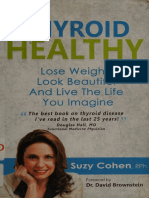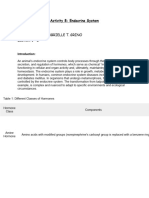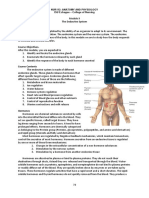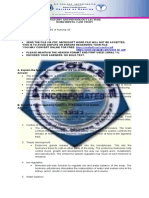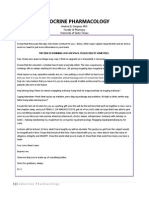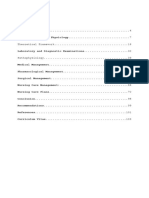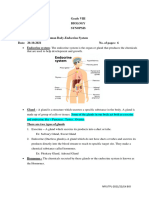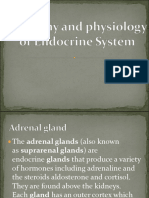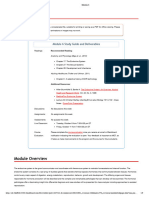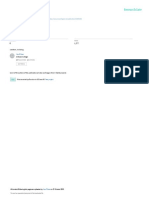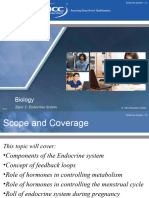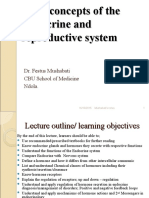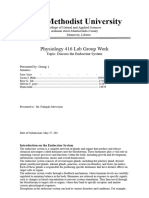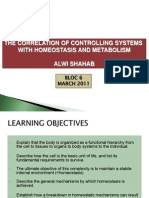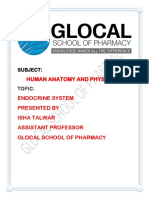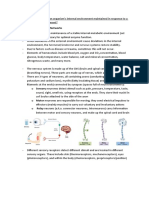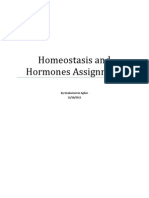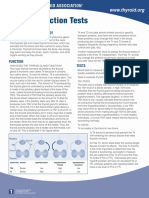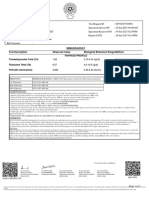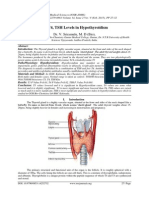NURSING ANAPHY Lec Session #13 - SAS (NEW FORMAT)
NURSING ANAPHY Lec Session #13 - SAS (NEW FORMAT)
Uploaded by
Kriztel Andrei Lapac NavajaCopyright:
Available Formats
NURSING ANAPHY Lec Session #13 - SAS (NEW FORMAT)
NURSING ANAPHY Lec Session #13 - SAS (NEW FORMAT)
Uploaded by
Kriztel Andrei Lapac NavajaCopyright
Available Formats
Share this document
Did you find this document useful?
Is this content inappropriate?
Copyright:
Available Formats
NURSING ANAPHY Lec Session #13 - SAS (NEW FORMAT)
NURSING ANAPHY Lec Session #13 - SAS (NEW FORMAT)
Uploaded by
Kriztel Andrei Lapac NavajaCopyright:
Available Formats
Anatomy & Physiology – Lecture (Nursing)
Module #13 Student Activity Sheet
Name: _________________________________________________________________ Class number: _______
Section: ____________ Schedule: ________________________________________ Date: ________________
Lesson title: ENDOCRINE SYSTEM (Part 2)
Learning Targets:
At the end of the module, students will be able to:
1. Identify the major hormones secreted from the other Materials: Book, pen and notebook
endocrine glands and its role in homeostasis;
2. Describe various conditions associated with problem in
hormone production of some endocrine glands;
3. Recognize the functions of other hormones significant in
References:
homeostasis;
4. Identify the different disorders and diseases associated with VanPutte, C., Regan, J., & Russo, A.
endocrine system and its description; and, (2019). Seeley’s essentials of anatomy &
5. List the major age-related changes that occur in the physiology (10th ed.). New York, NY:
endocrine system. McGraw-Hill Education.
A. LESSON REVIEW/PREVIEW
The purpose of this activity is to refresh your memory regarding the endocrine system. You simply encircle
your choice of answer based from the stated description in each item. Have fun!
1. Autocrine or Paracrine. Local messengers secreted by one cell type; ex: histamine
2. Lipid-soluble or Water-soluble. Most circulate as free hormones
3. Humoral or Neural or Hormonal. Directly by blood-borne chemicals to hormones
4. Nuclear receptors or Membrane-bound receptors. The hormone-receptor complex activates
genes, which in turn activate the DNS to produce mRNA
5. Anterior or Posterior. Releases antidiuretic hormones
B. MAIN LESSON
You must read & study the concepts and refer to figures/tables in Chapter 10 of the book.
Thyroid Gland – made up of two lobes connected by isthmus; located on each side of trachea & highly
vascular
✔ Function: To secrete thyroid hormones which bind to nuclear receptors in cells & regulate rate of
metabolism
✔ Thyroid hormones are synthesized and stored within thyroid follicles and attached to
thyroglobulin
✔ Parafollicular cells / C cells secrete the calcitonin
✔ Hormones are regulated by TSH-releasing hormone (TRH) from hypothalamus & thyroid-
stimulating hormone (TSH) from anterior pituitary gland (See process figure 10.16, page 280)
This document is the property of PHINMA EDUCATION 1 of 10
Anatomy & Physiology – Lecture (Nursing)
Module #13 Student Activity Sheet
Name: _________________________________________________________________ Class number: _______
Section: ____________ Schedule: ________________________________________ Date: ________________
Conditions associated with Thyroid Glands:
▪ Goiter – enlargement of thyroid gland; can develop from too low iodine in diet or excess in TSH
▪ Hypothyroidism – lack of thyroid hormones
o Cretinism: hypothyroidism that occurs in infant which is characterized by mental
retardation, short stature, and abnormally formed skeletal structures
o Myxedema: occurs in adults; characterized by extremely lethargic, having a hard time
performing routine task, and accumulation of fluid & other molecules in subcutaneous
tissue of skin
▪ Hyperthyroidism – elevated rate of thyroid hormones secretion that causes increased metabolic
rate, extreme nervousness, & chronic fatigue
o Graves’ Disease: an autoimmune disease that causes hyperthyroidism; occurs when
immune system produces abnormal proteins that are similar in structure & function to TSH,
over-stimulating thyroid gland
✔ Exophthalmos – bulging of the eyes associated with Graves’ disease
Parathyroid Glands – four tiny glands embedded in posterior wall of thyroid glands; release parathyroid
hormone (PTH) which is considered more important the calcitonin in Ca2+ regulation (See figure 10.17,
page 281)
Conditions associated with Parathyroid Glands:
▪ Hyperparathyroidism – abnormally high rate of PTH secretion usually caused by tumor in the
gland; results to easily fractured bones, fatigue, muscle weakness, and kidney stones
▪ Hypoparathyroidism – abnormally low rate of PTH secretion; may result from injury or surgical
removal of thyroid & parathyroid glands; characterized by frequent muscle cramps & tetanus
Adrenal Glands – two small glands located superior to each kidney; divided into adrenal medulla &
adrenal cortex (See process figures 10.18-10.21, page 282-285)
This document is the property of PHINMA EDUCATION 2 of 10
Anatomy & Physiology – Lecture (Nursing)
Module #13 Student Activity Sheet
Name: _________________________________________________________________ Class number: _______
Section: ____________ Schedule: ________________________________________ Date: ________________
Renin-Angiotensin-Aldosterone System (RAAS): This system is activated when the blood pressure
drops.
Renin is released from kidneys
▼
Stimulate conversion of angiotensinogen to angiotensin I in liver
▼
In lungs, angiotensin I converts angiotensin II by use of angiotensin-converting enzyme (ACE)
▼
Angiotensin II is a potent vasoconstrictor & causes release of aldosterone
▼
Blood pressure increases
Pancreas – has of pancreatic islets (islet of Langerhans) which consist of three cell types that are vital in
regulation of blood levels of glucose: (See figure 10.23, page 287)
▪ Alpha Cells – secrete glucagon
▪ Beta Cells – secrete insulin
▪ Delta Cells – secrete somatostatin
This document is the property of PHINMA EDUCATION 3 of 10
Anatomy & Physiology – Lecture (Nursing)
Module #13 Student Activity Sheet
Name: _________________________________________________________________ Class number: _______
Section: ____________ Schedule: ________________________________________ Date: ________________
Effects of Insulin and Glucagon on Target Tissues: (See table 10.3, page 286)
Somatostatin – response to food intake; inhibits secretion of insulin & glucagon; also inhibits gastric tract
activity.
Conditions associated with Pancreas:
▪ Acidosis – reduced pH of body fluids below normal; associated with breakdown of lipids releasing
enough fatty acids & ketones when blood glucose levels are very low
▪ Hyperglycemia – very high blood glucose levels
▪ Diabetes Mellitus (DM) – inability to regulate blood glucose levels within normal range; results of
exaggerated appetite, excess urine production, dehydration, thirst, & fatigue; has two types:
o Type 1 DM: occurs when too little insulin is secreted from pancreas
o Type 2 DM: caused by either too few insulin receptors or defective receptors (do not
respond normally to insulin) on target cells
▪ Insulin Shock – too much insulin is present in blood; occurs when a diabetic injected too much
insulin or has not eaten after an insulin injection; may result to disorientation, convulsion, & loss of
consciousness
Reproductive Organs – include testes in males & ovaries in females; hormone release is stimulated by LH
& FSH
Thymus – lies in upper part of thorax; most important early in life for normal development of immune system
in infant
This document is the property of PHINMA EDUCATION 4 of 10
Anatomy & Physiology – Lecture (Nursing)
Module #13 Student Activity Sheet
Name: _________________________________________________________________ Class number: _______
Section: ____________ Schedule: ________________________________________ Date: ________________
Pineal Gland – small, pinecone-shaped structure located in thalamus; play an important role in the onset
of puberty
Other Hormones:
1. Hormones secreted by cells in lining of stomach & small intestine – stimulate the production of
digestive juices from stomach, pancreas, & liver
✔ secretion occurs when food is present in digestive system
✔ hormones from small intestine help in regulation of rate at which food passes (stomach into
the intestine)
2. Prostaglandin – intercellular signal that are widely distributed in body & play a role in inflammation
✔ released by damaged tissues causing blood vessel dilation, localized swelling, & pain
✔ causes relaxation of smooth muscles (ex: dilation of blood vessels) & contraction of smooth
muscles (ex: uterine contraction during delivery); medically used to induce abortion
✔ produced by platelets for normal blood clotting
✔ aspirin – inhibits prostaglandin synthesis
3. Atrial Natriuretic Hormone (ANH) / Atrial Natriuretic Peptide (ANP) – secreted by right atrium
of heart in response to elevated blood pressure; inhibits Na+ reabsorption in kidneys resulting to
more urine to be excreted
4. Erythropoietin – secreted in response to reduced oxygen levels in kidneys; acts on bone marrow
to increase production of RBC
5. Human Chorionic Gonadotropin (HCG) – similar in structure & function of LH; secreted by
placenta to maintain pregnancy & stimulate breast development
Diseases and Disorders of Endocrine System:
For the listed conditions below, refer to Table 10.4, page 290 of the book for description:
■ Diabetes Insipidus
■ Hashimoto Thyroiditis
■ Primary Hyperparathyroidism
■ Addison Disease
■ Gestational Diabetes
Effects of Aging on the Endocrine System:
▪ Gradual decrease in growth hormone in people who do not exercise melatonin, reproductive
hormones, thymosin, and thyroid hormones (slight decrease).
▪ Parathyroid hormones increase if vitamin D and Ca2+ decrease.
▪ There is an increase in type 2 diabetes mellitus in people with a familial tendency.
This document is the property of PHINMA EDUCATION 5 of 10
Anatomy & Physiology – Lecture (Nursing)
Module #13 Student Activity Sheet
Name: _________________________________________________________________ Class number: _______
Section: ____________ Schedule: ________________________________________ Date: ________________
CHECK FOR UNDERSTANDING
You will answer and rationalize this by yourself. This will be recorded as your quiz. One (1) point will be
given to the correct answer and another one (1) point for the correct ratio. Superimpositions or erasures
in your answer/ratio is not allowed. You are given 20 minutes for this activity.
Multiple Choice
1. Which of the following is incorrectly paired with its location or function?
a. C cells; scattered throughout loose connective tissue between thyroid follicles
b. C cells; secretion of calcitonin
c. thyroglobulin; scattered throughout loose connective tissue between thyroid follicles
d. thyroglobulin; colloid of thyroid follicles
e. thyroid hormones; regulation of metabolic rate in the body
ANSWER: ________
RATIO:______________________________________________________________________________
____________________________________________________________________________________
____________________________________________________________________________________
_______________________________________
2. Gonadotropins:
a. are secreted by the posterior pituitary.
b. regulate growth, development and function of the ovaries and testes.
c. include both TSH and ACTH.
d. are controlled by a releasing hormone from the thyroid gland.
e. directly promote water retention by the kidneys.
ANSWER: ________
RATIO:______________________________________________________________________________
____________________________________________________________________________________
____________________________________________________________________________________
_______________________________________
3. All are true regarding growth hormone, except:
a. stimulates fat synthesis.
b. favors protein breakdown.
c. deficiency in an adult can produce pituitary gigantism.
d. excess after growth is complete produces acromegaly.
ANSWER: ________
RATIO:______________________________________________________________________________
____________________________________________________________________________________
____________________________________________________________________________________
_______________________________________
4. Which of these statements is true regarding antidiuretic hormone (ADH)?
a. is sometimes called oxytocin.
b. can cause blood vessels to constrict when present in the blood in large amounts.
c. causes "milk letdown" from the breasts of lactating women.
d. stimulates melanocytes and causes them to synthesize melanin.
This document is the property of PHINMA EDUCATION 6 of 10
Anatomy & Physiology – Lecture (Nursing)
Module #13 Student Activity Sheet
Name: _________________________________________________________________ Class number: _______
Section: ____________ Schedule: ________________________________________ Date: ________________
e. is sometimes called oxytocin and can cause blood vessels to constrict when present in the
blood in large amounts as properties.
ANSWER: ________
RATIO:______________________________________________________________________________
____________________________________________________________________________________
____________________________________________________________________________________
_______________________________________
5. Calcitonin:
a. is secreted by the parathyroid glands.
b. increases the amount of calcium absorbed by the intestine.
c. is synthesized by C cells of the thyroid gland.
d. increases the rate of calcium release from bone.
e. is secreted when blood calcium levels drop too low.
ANSWER: ________
RATIO:______________________________________________________________________________
____________________________________________________________________________________
____________________________________________________________________________________
_______________________________________
6. Symptoms of diabetes mellitus include:
a. increased appetite. d. limited urine output.
b. lack of thirst. e. All of these are true.
c. high energy level.
ANSWER: ________
RATIO:______________________________________________________________________________
____________________________________________________________________________________
____________________________________________________________________________________
_______________________________________
7. Which of these hormones increases blood glucose levels and increases lipid breakdown, but slows
protein breakdown?
a. glucagon d. glucocorticoids
b. epinephrine e. growth hormone
c. insulin
ANSWER: ________
RATIO:______________________________________________________________________________
____________________________________________________________________________________
____________________________________________________________________________________
_______________________________________
8. Which of these statements concerning aldosterone secretion is NOT correct?
a. Low blood pressure stimulates the release of renin from the kidney.
b. Renin causes angiotensinogen to be converted to angiotensin I.
c. Angiotensin II acts on the adrenal cortex to increase aldosterone secretion.
d. Aldosterone causes increased potassium retention.
e. Angiotensin II constricts blood vessels.
ANSWER: ________
This document is the property of PHINMA EDUCATION 7 of 10
Anatomy & Physiology – Lecture (Nursing)
Module #13 Student Activity Sheet
Name: _________________________________________________________________ Class number: _______
Section: ____________ Schedule: ________________________________________ Date: ________________
RATIO:______________________________________________________________________________
____________________________________________________________________________________
____________________________________________________________________________________
_______________________________________
9. The thymus gland: (Select all that apply)
a. becomes prominent with increasing age. c. secretes thymosin.
b. is important in the function of the immune d. is found in the upper part of the thoracic
system. cavity above the heart.
ANSWER: ________
RATIO:______________________________________________________________________________
____________________________________________________________________________________
____________________________________________________________________________________
_______________________________________
10. Pepper has been diagnosed with an abnormally high level of melanocyte-stimulating hormone (MSH).
You know that she would exhibit which of the following symptoms?
a. hyperglycemia d. darkening of the skin
b. reduced egg cell production e. constant thirst
c. increased frequency of urination
ANSWER: ________
RATIO:______________________________________________________________________________
____________________________________________________________________________________
____________________________________________________________________________________
_______________________________________
This document is the property of PHINMA EDUCATION 8 of 10
Anatomy & Physiology – Lecture (Nursing)
Module #13 Student Activity Sheet
Name: _________________________________________________________________ Class number: _______
Section: ____________ Schedule: ________________________________________ Date: ________________
C. LESSON WRAP-UP
AL Activity: LEARNING SHEETS
This technique will help you engage by providing a question sheet that guides & stimulates the learning.
You will answer the questions per column, as fast as you can. It will be great to time yourself as you answer
on the space provided. Have fun!
FIND-OUT QUESTIONS:
1. Hormones released by the anterior pituitary gland to stimulate the hormones of thyroid gland.
Answer: ____________________________
2. Cells that secrete insulin. Answer: ____________________________
3. This hormone is released when there is an abnormally low calcium blood level.
Answer: ____________________________
4. The gland responsible for the onset of puberty. Answer: ____________________________
5. A disorder that is caused by lack of ADH from posterior pituitary. Answer: ____________________________
LARGER QUESTIONS: (These can only be answered if the FIND-OUT QUESTIONS are completed.)
1. Compare the functions of the hormones released by ovaries, the LH and FSH.
______________________________________________________________________________________
______________________________________________________________________________________
______________________________________________________________________________________
______________________________________________________________________________________
2. What is the major function of glucagon in the body?
______________________________________________________________________________________
______________________________________________________________________________________
______________________________________________________________________________________
______________________________________________________________________________________
3. Describe the functions of each hormone released by the adrenal cortex.
______________________________________________________________________________________
______________________________________________________________________________________
______________________________________________________________________________________
______________________________________________________________________________________
This document is the property of PHINMA EDUCATION 9 of 10
Anatomy & Physiology – Lecture (Nursing)
Module #13 Student Activity Sheet
Name: _________________________________________________________________ Class number: _______
Section: ____________ Schedule: ________________________________________ Date: ________________
CHALLENGE QUESTION:
1. Why does a pregnant woman contain a numerous amount of progesterone and HCG compared to non-
pregnant?
This document is the property of PHINMA EDUCATION 10 of 10
You might also like
- MKSAP Endocrinology and MetabolismDocument148 pagesMKSAP Endocrinology and MetabolismArthurHLima100% (2)
- Thyroid Healthy Iodine, Lose Weight, Look Beautiful and Live The Life You Imagine (Suzy Cohen RPH, David Brownstein) (Z-Library)Document308 pagesThyroid Healthy Iodine, Lose Weight, Look Beautiful and Live The Life You Imagine (Suzy Cohen RPH, David Brownstein) (Z-Library)Анна Варданян100% (2)
- Endocrine ReviewDocument9 pagesEndocrine ReviewSpencer ThomasNo ratings yet
- ANAPHY Lec Session #13 - SAS (Agdana, Nicole Ken)Document9 pagesANAPHY Lec Session #13 - SAS (Agdana, Nicole Ken)Nicole Ken AgdanaNo ratings yet
- Science 10 SLG1Document4 pagesScience 10 SLG1Arque John Bertumen AbieraNo ratings yet
- Chapter 018Document12 pagesChapter 018api-281340024No ratings yet
- Activity 8. Endocrine SystemDocument9 pagesActivity 8. Endocrine SystemmendozakaceeyNo ratings yet
- The Endocrine System Overview/ Introduction: Nur112: Anatomy and Physiology ISU Echague - College of NursingDocument6 pagesThe Endocrine System Overview/ Introduction: Nur112: Anatomy and Physiology ISU Echague - College of NursingWai KikiNo ratings yet
- Endocrine Case StudyDocument3 pagesEndocrine Case StudyJenny ViNo ratings yet
- Department of Education: Region V-Bicol Schools Division of Iriga CityDocument4 pagesDepartment of Education: Region V-Bicol Schools Division of Iriga Citymaricar relatorNo ratings yet
- Blok 4 Skenario 1Document14 pagesBlok 4 Skenario 1Dots FfastNo ratings yet
- Week 15 16 Module Biochem Lec EndocrinologyDocument19 pagesWeek 15 16 Module Biochem Lec EndocrinologyLy xyNo ratings yet
- Endocrineglands 140817003157 Phpapp01Document61 pagesEndocrineglands 140817003157 Phpapp01Musfira KhalidNo ratings yet
- Competency Appraisal 2 SyllabusDocument10 pagesCompetency Appraisal 2 SyllabusMary Janet Pinili100% (2)
- Essentials of Anatomy & Physiology: The Endocrine SystemDocument52 pagesEssentials of Anatomy & Physiology: The Endocrine SystemMarrenSalvadorNo ratings yet
- Endocrine System Anatomy and Physiology - NurseslabsDocument29 pagesEndocrine System Anatomy and Physiology - NurseslabsAlyssum Marie50% (2)
- Endocrine SystemDocument6 pagesEndocrine SystemCaviles, Jasmin S.No ratings yet
- 2013 ENDOCRINE PHARMACOLOGY Word Notes PDFDocument52 pages2013 ENDOCRINE PHARMACOLOGY Word Notes PDFNicole Opao100% (4)
- SASDocument6 pagesSASNicole Ken AgdanaNo ratings yet
- Antonio Maria Yssabelle B. - Module 5 - Laboratory ActivitiesDocument6 pagesAntonio Maria Yssabelle B. - Module 5 - Laboratory ActivitiesRovic Selga TrisinioNo ratings yet
- Research Paper Endocrine SystemDocument8 pagesResearch Paper Endocrine Systemefjddr4z100% (1)
- A Module On Human Body: Lesson V: The Endocrine SystemDocument8 pagesA Module On Human Body: Lesson V: The Endocrine Systemapi-3731377No ratings yet
- EndocrineDocument9 pagesEndocrineEmmanuel A. GalvanNo ratings yet
- SLP Hypothalamus and Pituitary IIDocument6 pagesSLP Hypothalamus and Pituitary IIMuhd ArsyadNo ratings yet
- GroupNo2 Bauyon LabActivityNo12Document6 pagesGroupNo2 Bauyon LabActivityNo12tel krisNo ratings yet
- 1. D 3.3 SL HomeostasisDocument72 pages1. D 3.3 SL HomeostasisJyoti SinghNo ratings yet
- Endocrine SystemDocument15 pagesEndocrine System23011514-041No ratings yet
- Inp Clinical Forum FinalDocument110 pagesInp Clinical Forum FinalJayvee CornelioNo ratings yet
- Grade VIII Biology Synopsis Theme 4: Unit 1 Name of The Chapter: Human Body-Endocrine System Date: 20-10-2021 No. of Pages: 6Document6 pagesGrade VIII Biology Synopsis Theme 4: Unit 1 Name of The Chapter: Human Body-Endocrine System Date: 20-10-2021 No. of Pages: 6shashwatthegamerytNo ratings yet
- Endocrine SystemDocument18 pagesEndocrine SystemAshwini ONo ratings yet
- MODULE 1 Assessment of The Endocrine SystemDocument31 pagesMODULE 1 Assessment of The Endocrine SystemLorraine GambitoNo ratings yet
- Module 6Document9 pagesModule 6rhui1No ratings yet
- HistologyThyroidGland StatPearls NCBIBookshelf 1Document14 pagesHistologyThyroidGland StatPearls NCBIBookshelf 1Mohammed FaragNo ratings yet
- Histology, Thyroid Gland: July 2020Document14 pagesHistology, Thyroid Gland: July 2020Angelita Torres LlacsahuangaNo ratings yet
- Biology Lecture 3 Endocrine SystemDocument31 pagesBiology Lecture 3 Endocrine SystemAfifa HaqueNo ratings yet
- Portfolio IN Histology Laboratory: Submitted To: Tom Anthony Tonguia, RMT Submitted By: Charlene Caro 2A-BsmlsDocument9 pagesPortfolio IN Histology Laboratory: Submitted To: Tom Anthony Tonguia, RMT Submitted By: Charlene Caro 2A-BsmlsFearless AngelNo ratings yet
- Transport in PlantDocument21 pagesTransport in PlantIsheba WarrenNo ratings yet
- Nursing Anaphy Lec Session #12 - Sas (New Format)Document6 pagesNursing Anaphy Lec Session #12 - Sas (New Format)Maria Vannesa Anne SalvacionNo ratings yet
- gr9 Bod 1 Endocrine SystemDocument5 pagesgr9 Bod 1 Endocrine SystemJesson CabantogNo ratings yet
- Biology 112: Chapter 11: The Endocrine SystemDocument5 pagesBiology 112: Chapter 11: The Endocrine SystemLuisNo ratings yet
- Lecture 1 Principles of EndocrinologyDocument82 pagesLecture 1 Principles of EndocrinologyHomeground entertainmentNo ratings yet
- 416 Lab WorkDocument4 pages416 Lab Workdcoleabell5No ratings yet
- Aljane Rose Mae Q. Visto BSN 2A Pharmacology Thyroid and Parathyroid Agents Quiz (20 Items)Document2 pagesAljane Rose Mae Q. Visto BSN 2A Pharmacology Thyroid and Parathyroid Agents Quiz (20 Items)Erma VistoNo ratings yet
- Homeostasis Is The Maintenance of A Stable Internal EnvironmentDocument44 pagesHomeostasis Is The Maintenance of A Stable Internal EnvironmentMOMINAH AbbasiNo ratings yet
- OT Endocrine SystemDocument53 pagesOT Endocrine SystemJei CorbesNo ratings yet
- The Correlation of Controlling Systems With Homeostasis and Metabolism Alwi ShahabDocument43 pagesThe Correlation of Controlling Systems With Homeostasis and Metabolism Alwi ShahabAnisa Karamina WardaniNo ratings yet
- Endocrine System PresentationDocument29 pagesEndocrine System PresentationTanayNo ratings yet
- 2020 BIO Module 8 Non Infectious Disease JessicaDocument12 pages2020 BIO Module 8 Non Infectious Disease JessicaGlenn MalynNo ratings yet
- Our Powerpoint On Homeostasis and Hormonal ControlDocument54 pagesOur Powerpoint On Homeostasis and Hormonal ControlNoel HymanNo ratings yet
- Sas25 Hes029 (Lab)Document4 pagesSas25 Hes029 (Lab)therese alcoverNo ratings yet
- NCM of Clients With Endocrine DisordersDocument24 pagesNCM of Clients With Endocrine DisordersArgee Alonsabe100% (1)
- Exam #1 Physiology Study GuideDocument27 pagesExam #1 Physiology Study GuideKamille TucaNo ratings yet
- TOPIC 3 - The Endocrine SystemDocument34 pagesTOPIC 3 - The Endocrine SystemKaren Pearl TagleNo ratings yet
- Endocrine GlandsDocument4 pagesEndocrine GlandsCare TutorialNo ratings yet
- Insuline HormoneDocument36 pagesInsuline HormoneF ParikhNo ratings yet
- Pituitary Gland and All Other Glands: Presented To: Miss SairaDocument23 pagesPituitary Gland and All Other Glands: Presented To: Miss SairaSheikh bikerNo ratings yet
- Homeostasis and Hormones AssignmentDocument4 pagesHomeostasis and Hormones AssignmentSivakumarran AgilanNo ratings yet
- المحاضرةالثانية 3كيمياء حيويDocument21 pagesالمحاضرةالثانية 3كيمياء حيويkhodaira2010No ratings yet
- Laboratory Activity Endocrinology: Table 1: Different Classes of HormonesDocument6 pagesLaboratory Activity Endocrinology: Table 1: Different Classes of HormonesJohn Fritz Gerald BascoNo ratings yet
- Endocrine-System 20231001 220830 0000Document33 pagesEndocrine-System 20231001 220830 0000murlastaceytormisNo ratings yet
- Chemical Coordination and Integration PDFDocument12 pagesChemical Coordination and Integration PDFSanjana SubramaniamNo ratings yet
- Healthy Habits for Managing & Reversing Prediabetes: 100 Simple, Effective Ways to Prevent and Undo PrediabetesFrom EverandHealthy Habits for Managing & Reversing Prediabetes: 100 Simple, Effective Ways to Prevent and Undo PrediabetesNo ratings yet
- Iodine Brownstein - AIT HolisticDocument139 pagesIodine Brownstein - AIT HolisticFrançois-Xavier Sarfati100% (1)
- The Entire Endocrinology Lectures Set PDFDocument385 pagesThe Entire Endocrinology Lectures Set PDFoakley bartNo ratings yet
- Thy 2016 0457 PDFDocument101 pagesThy 2016 0457 PDFsmsuju7No ratings yet
- Edma Classification ReagentsDocument82 pagesEdma Classification ReagentsHarun GanićNo ratings yet
- Thyroid Hormones and CVDDocument16 pagesThyroid Hormones and CVDYosefin RatnaningtyasNo ratings yet
- Dulutalias - Chapter18-THE ENDOCRINE SYSTEMDocument10 pagesDulutalias - Chapter18-THE ENDOCRINE SYSTEMGwen Valerie DulutaliasNo ratings yet
- Thyroid Gland An Diseases of Thyroid D Gland: Omc LectureDocument59 pagesThyroid Gland An Diseases of Thyroid D Gland: Omc LectureEdward Makembo100% (1)
- Representative Laboratory Reference Values: Blood, Plasma, and SerumDocument22 pagesRepresentative Laboratory Reference Values: Blood, Plasma, and SerumKubra ĖdrisNo ratings yet
- MailattDocument49 pagesMailattholanNo ratings yet
- Analytical Method For Cleaning Validation of Levothyroxine Sodium inDocument9 pagesAnalytical Method For Cleaning Validation of Levothyroxine Sodium inDidarulNo ratings yet
- Endocrine System: Dr. Dedi Ardinata, M.Kes Physiology Department Medical School of University Sumatera UtaraDocument94 pagesEndocrine System: Dr. Dedi Ardinata, M.Kes Physiology Department Medical School of University Sumatera UtaraAdryansyah ChaniagoNo ratings yet
- Bharati Report PDFDocument4 pagesBharati Report PDFSachin KothariNo ratings yet
- Z284Document3 pagesZ284Sandeep KaurNo ratings yet
- Standardized Lab Values - Final - 031215Document6 pagesStandardized Lab Values - Final - 031215isapatrick8126No ratings yet
- Laboratory Reference RangesDocument12 pagesLaboratory Reference RangesPrashanth Raju100% (1)
- Thyroid Function Test PDFDocument2 pagesThyroid Function Test PDFAlizaPinky100% (1)
- Newborn Screening StudentDocument39 pagesNewborn Screening StudentKeanu Win CatipayNo ratings yet
- Reiki Level 1 ManualDocument29 pagesReiki Level 1 ManualFabian DeeNo ratings yet
- PDF TextDocument3 pagesPDF TextYogita PalNo ratings yet
- Thyroid: Heal Thyself by Dr. Aaron ErnstDocument20 pagesThyroid: Heal Thyself by Dr. Aaron ErnstSheri LewNo ratings yet
- Risk Factors For Granulocytopenia in Patients With Graves' Disease Receiving Antithyroid DrugsDocument5 pagesRisk Factors For Granulocytopenia in Patients With Graves' Disease Receiving Antithyroid DrugsInterna UnhasNo ratings yet
- NASC 4 Fact or BluffDocument33 pagesNASC 4 Fact or BluffJona MangabanNo ratings yet
- T3, T4, TSH Levels in HypothyroidismDocument6 pagesT3, T4, TSH Levels in HypothyroidismInternational Organization of Scientific Research (IOSR)No ratings yet
- Questions 1 Through 10 Are Based On The Following Reading PassageDocument12 pagesQuestions 1 Through 10 Are Based On The Following Reading PassageSoonie Doongie DoryNo ratings yet
- Hipo HiperthyroidDocument49 pagesHipo HiperthyroidMuhammad Bilal Bin AmirNo ratings yet
- Hormones and The Endocrine System: For Campbell Biology, Ninth EditionDocument106 pagesHormones and The Endocrine System: For Campbell Biology, Ninth EditionLaode Abdul KadirNo ratings yet
- Adaptive Responses To Thermal Stress in MammalsDocument16 pagesAdaptive Responses To Thermal Stress in Mammalsciro ortizNo ratings yet
- Chapter 9 - Endocrine SystemDocument9 pagesChapter 9 - Endocrine SystemrishellemaepilonesNo ratings yet

